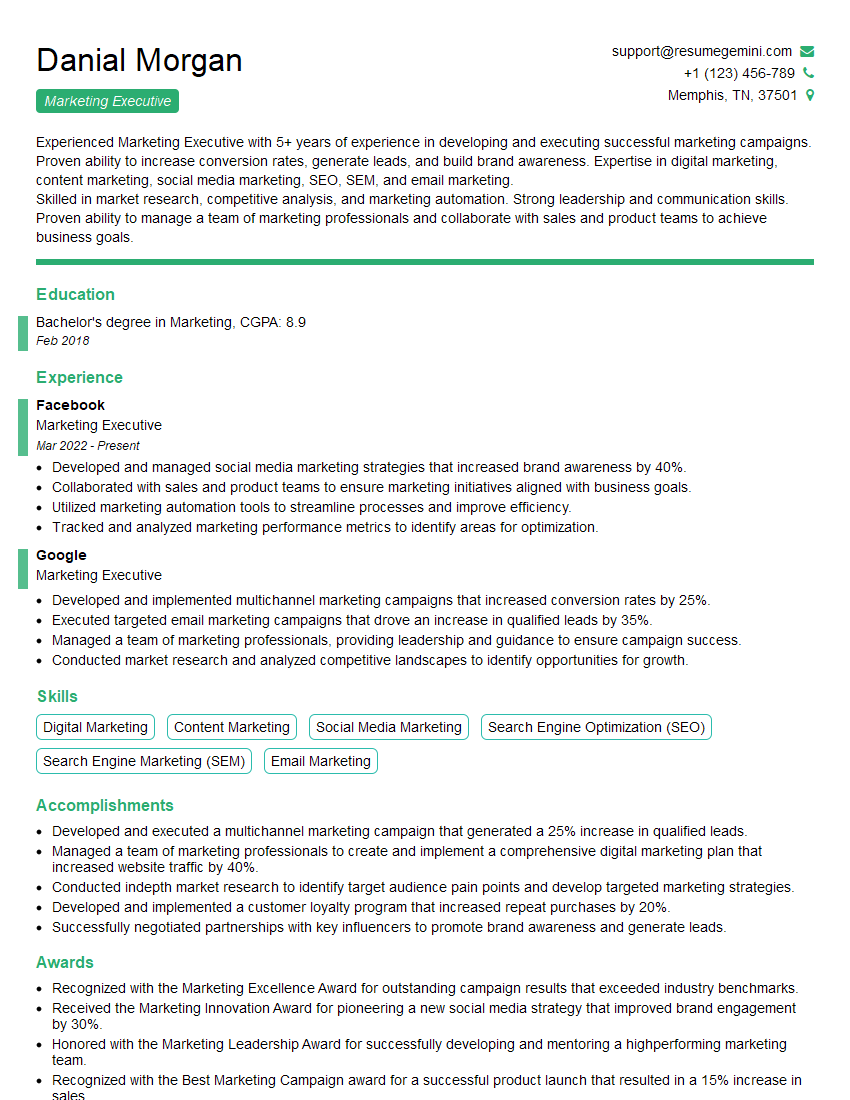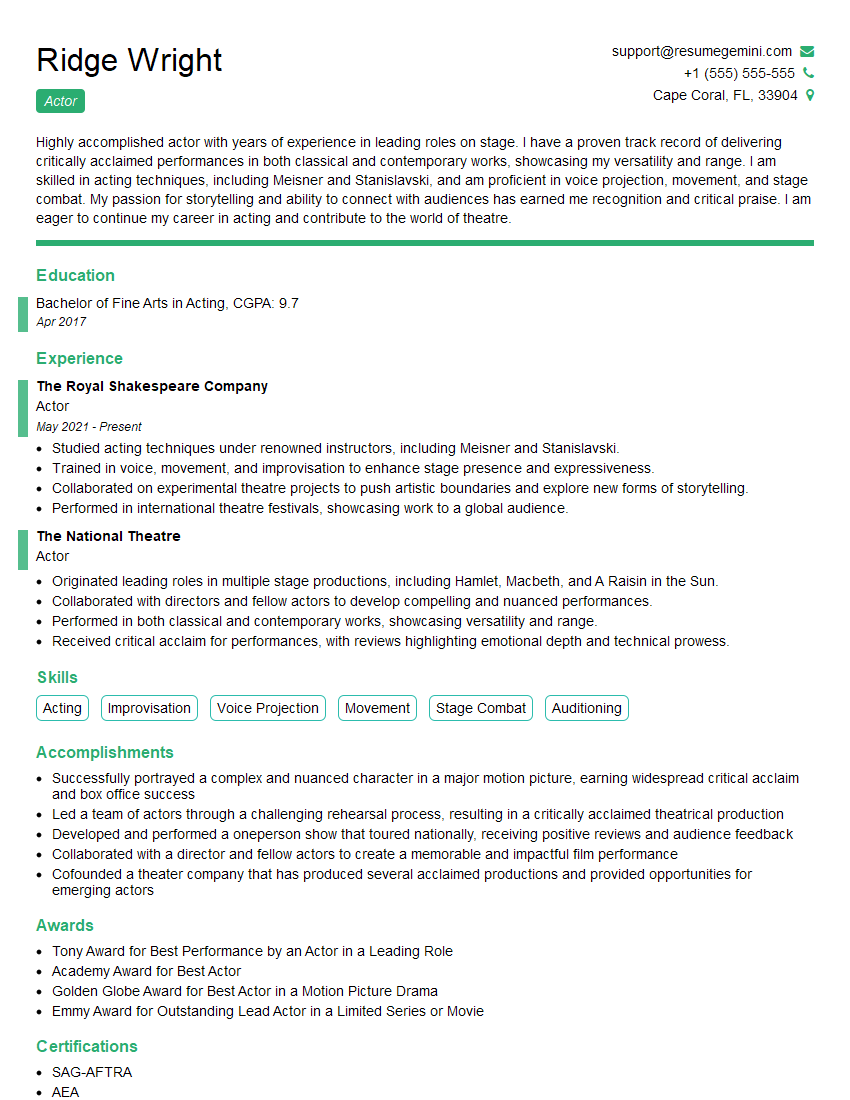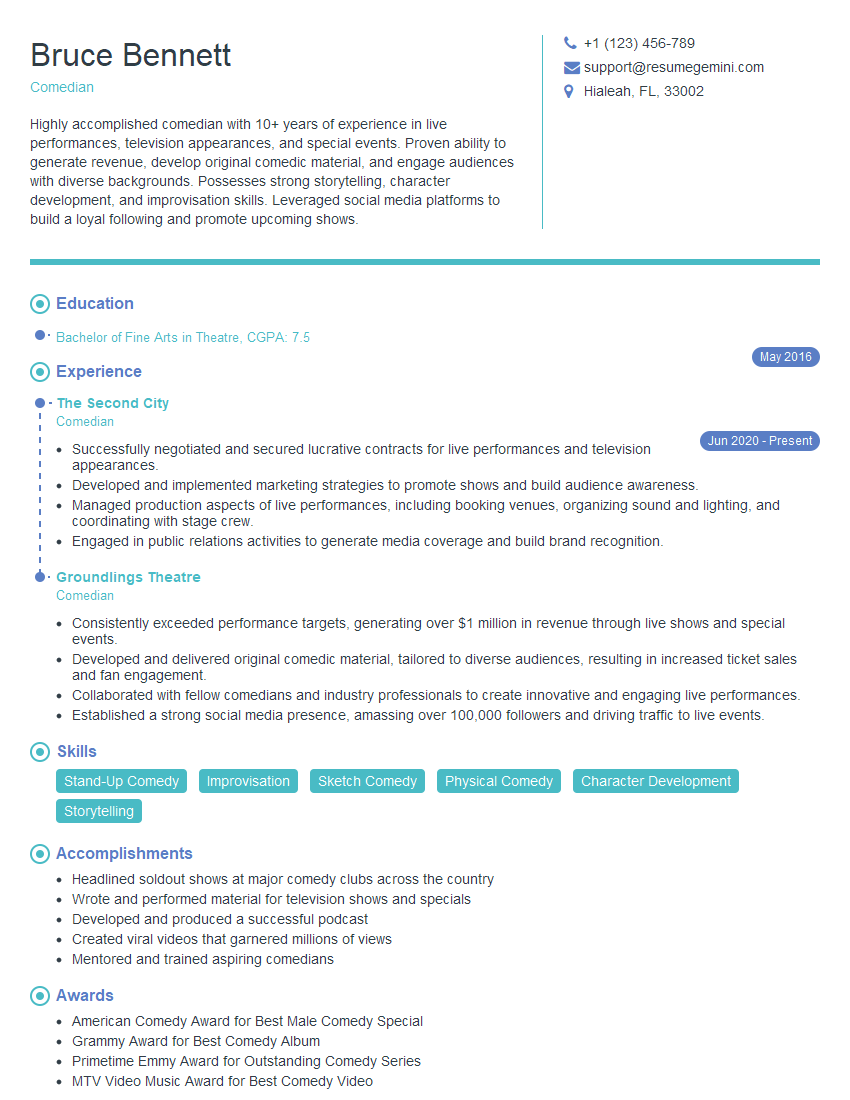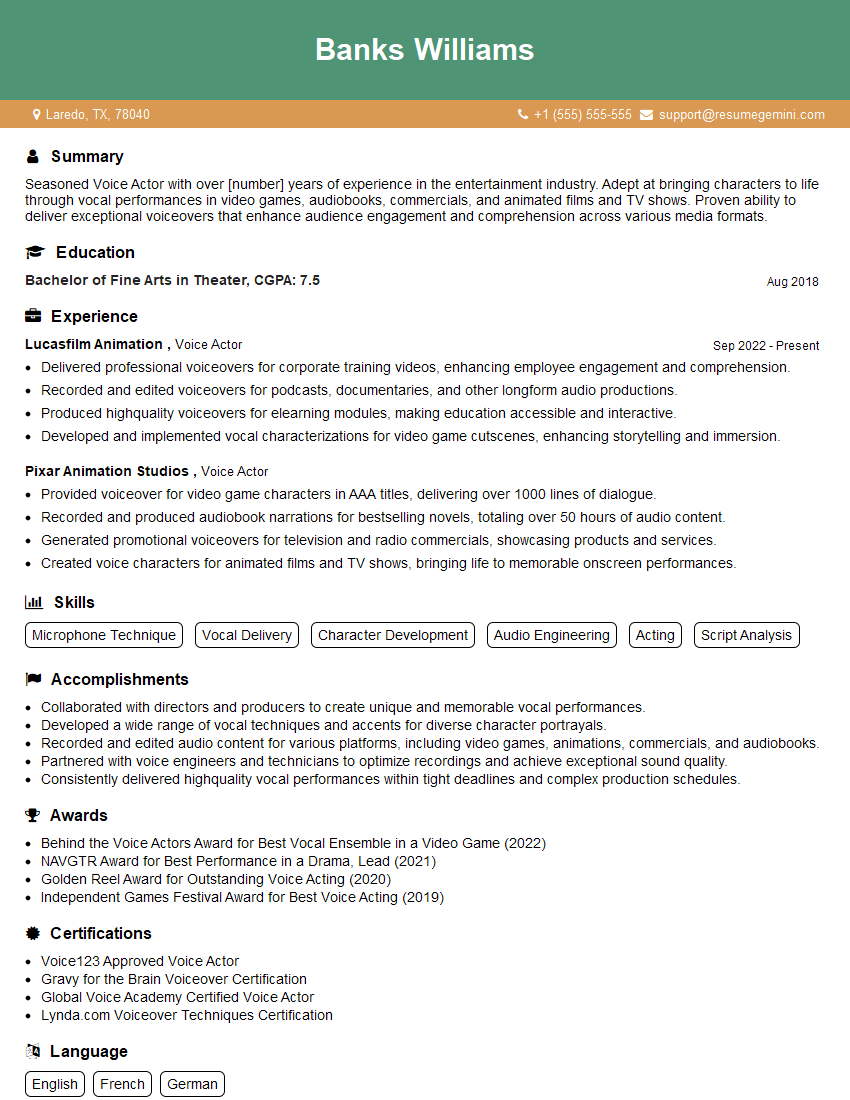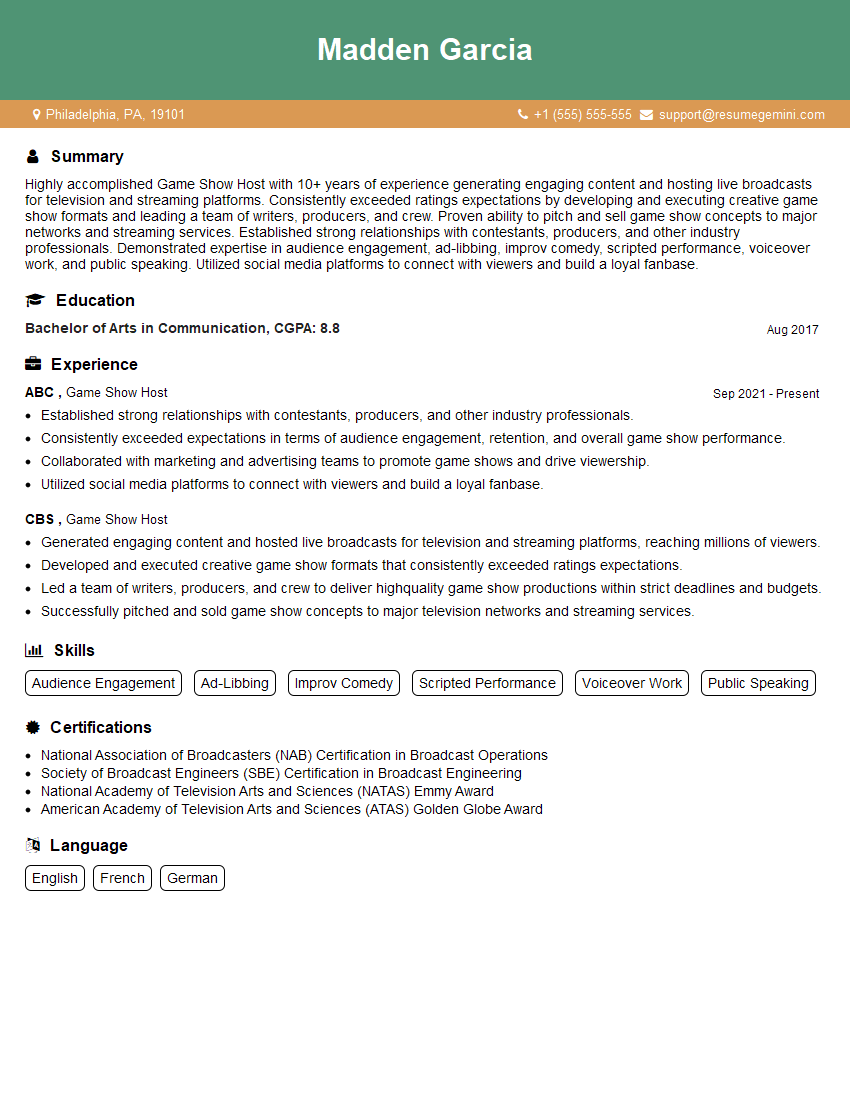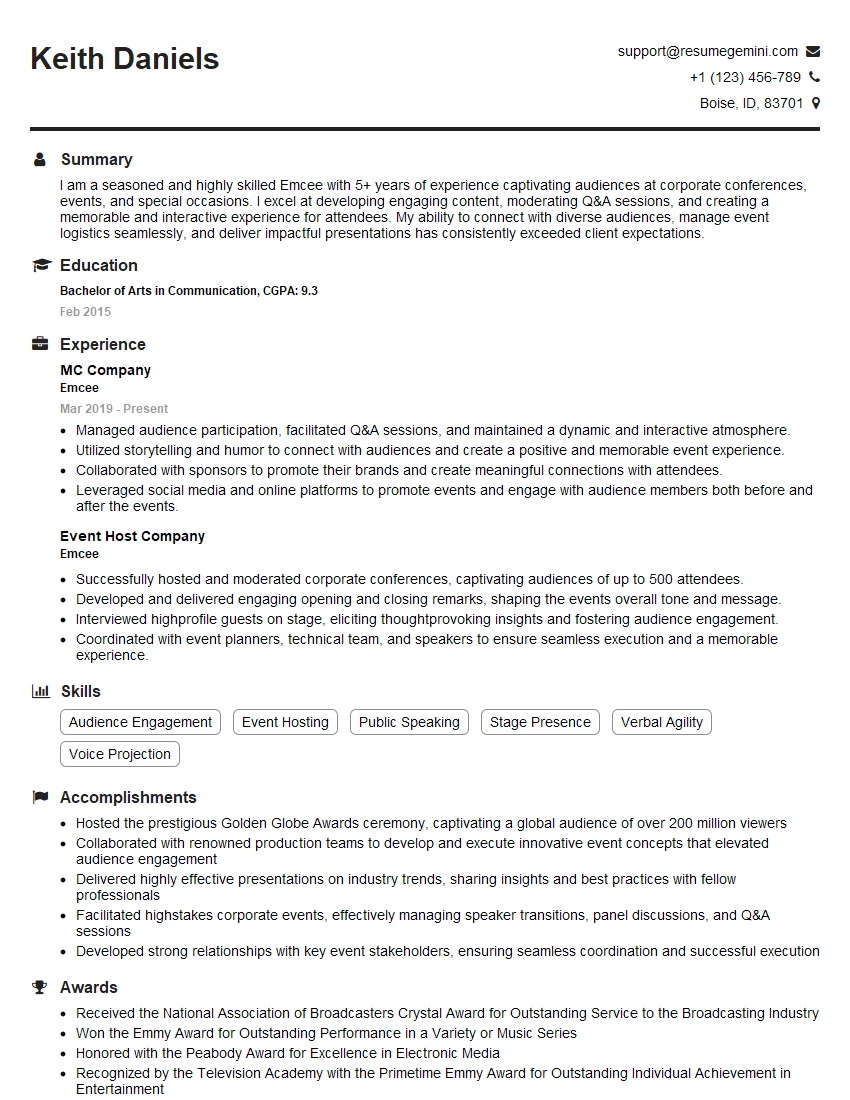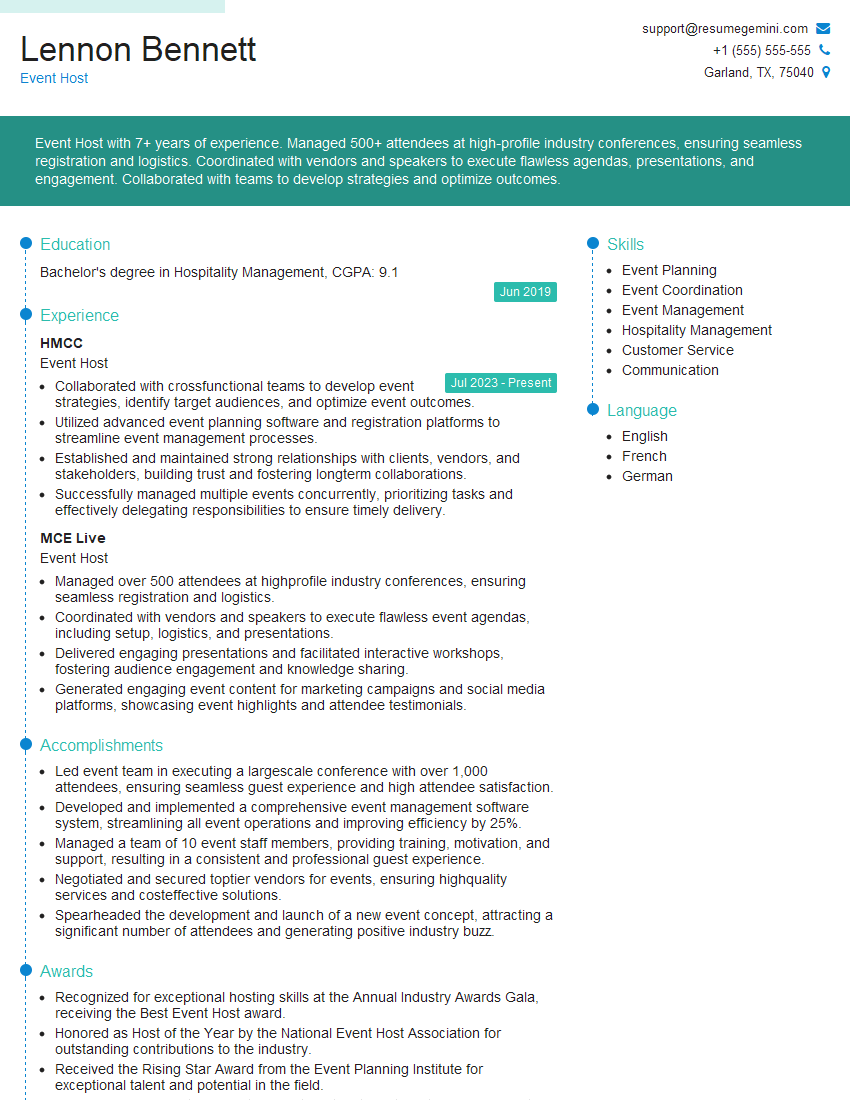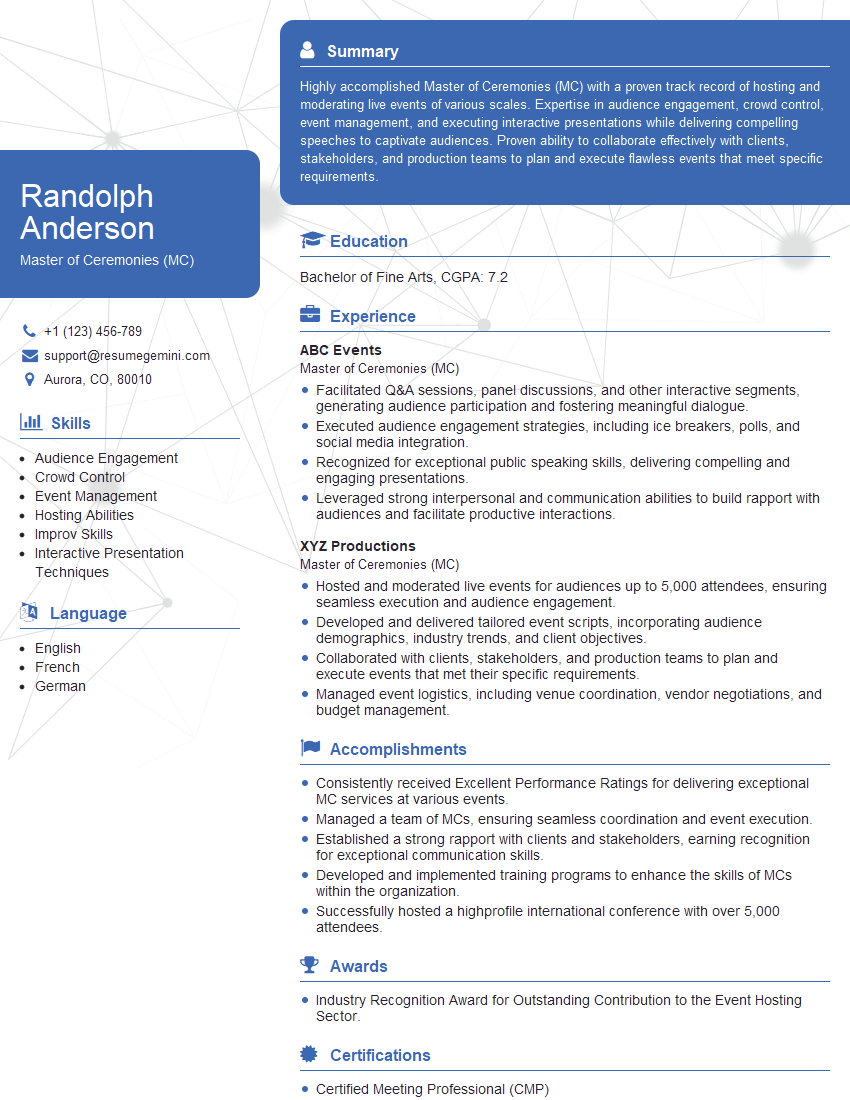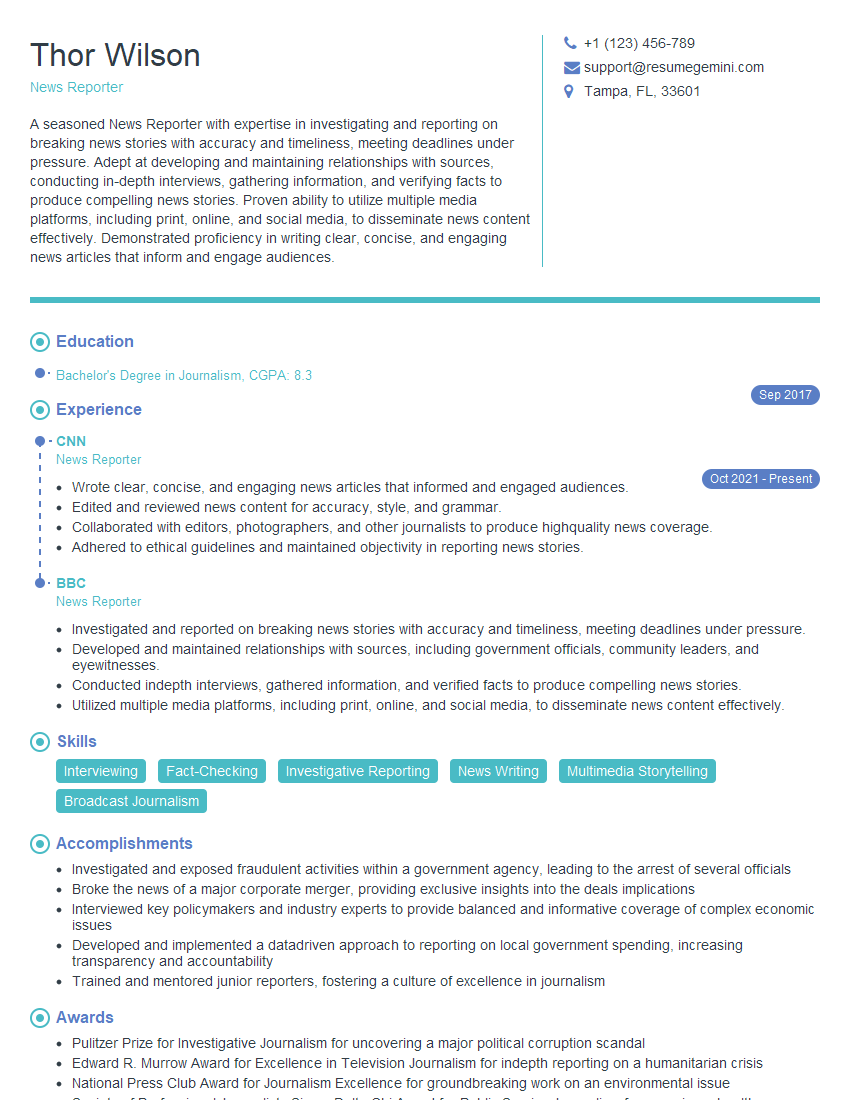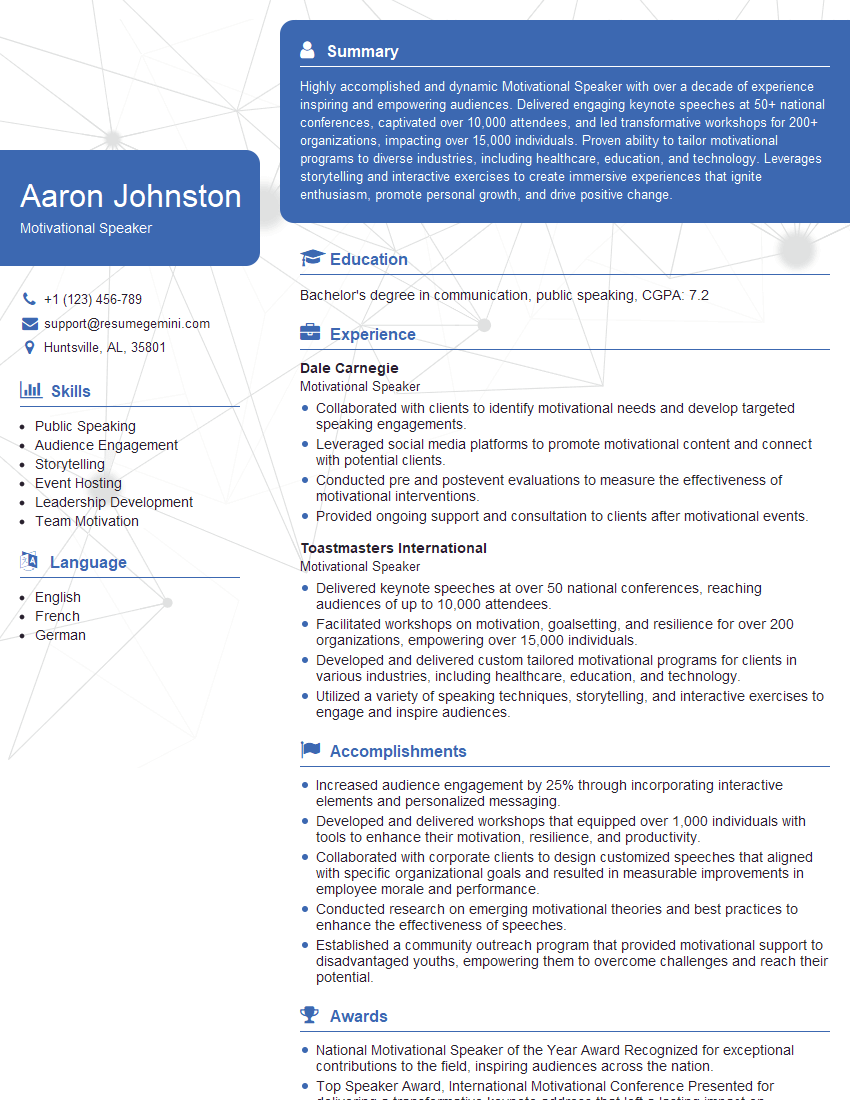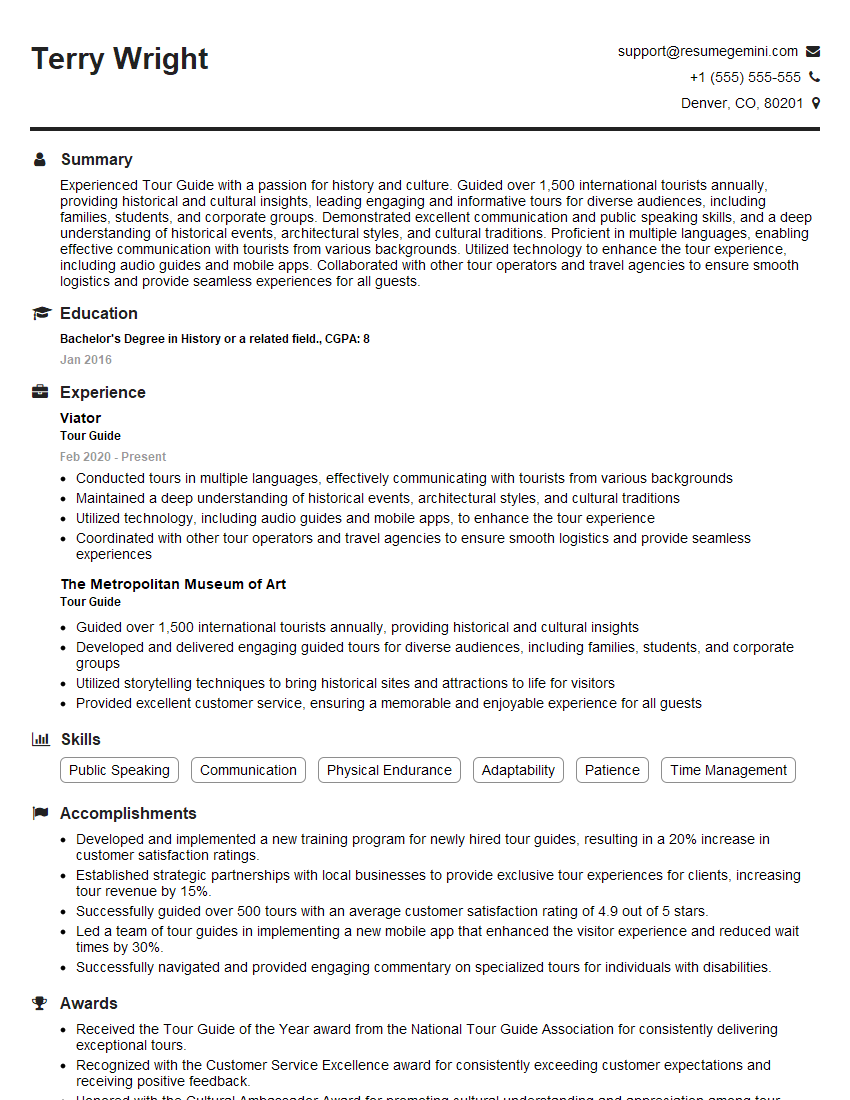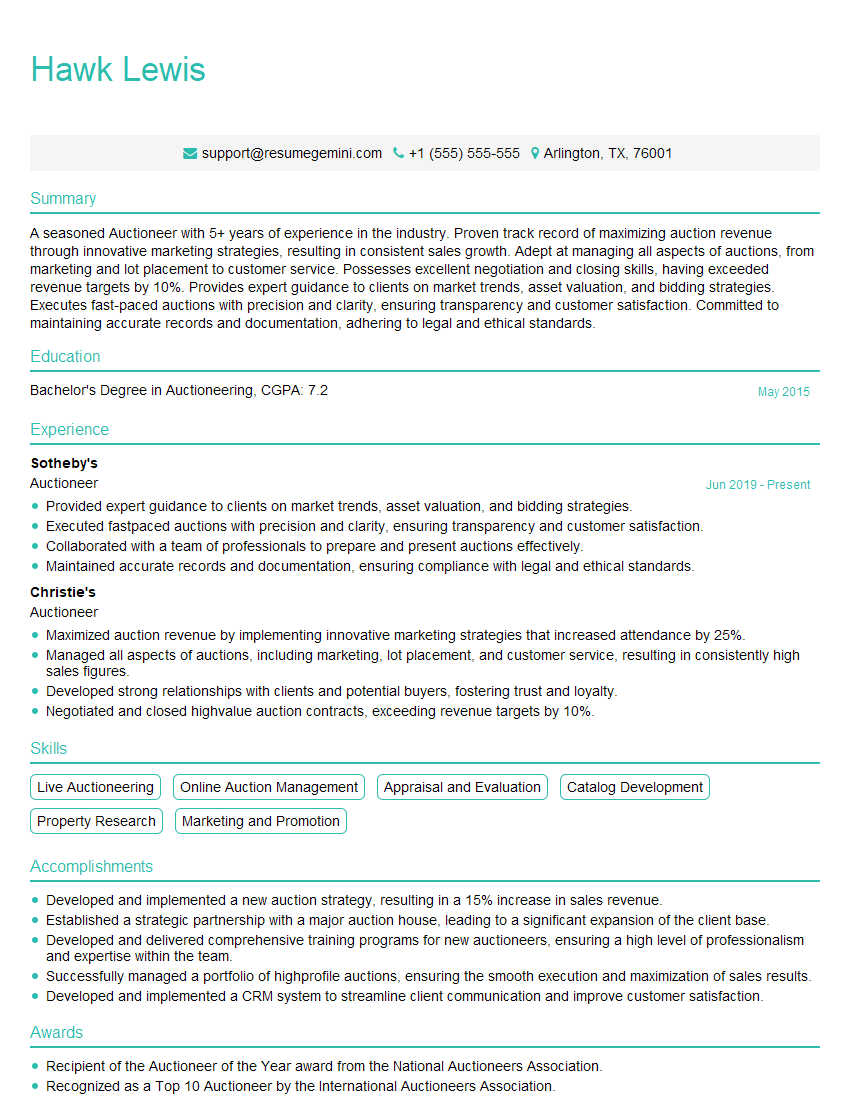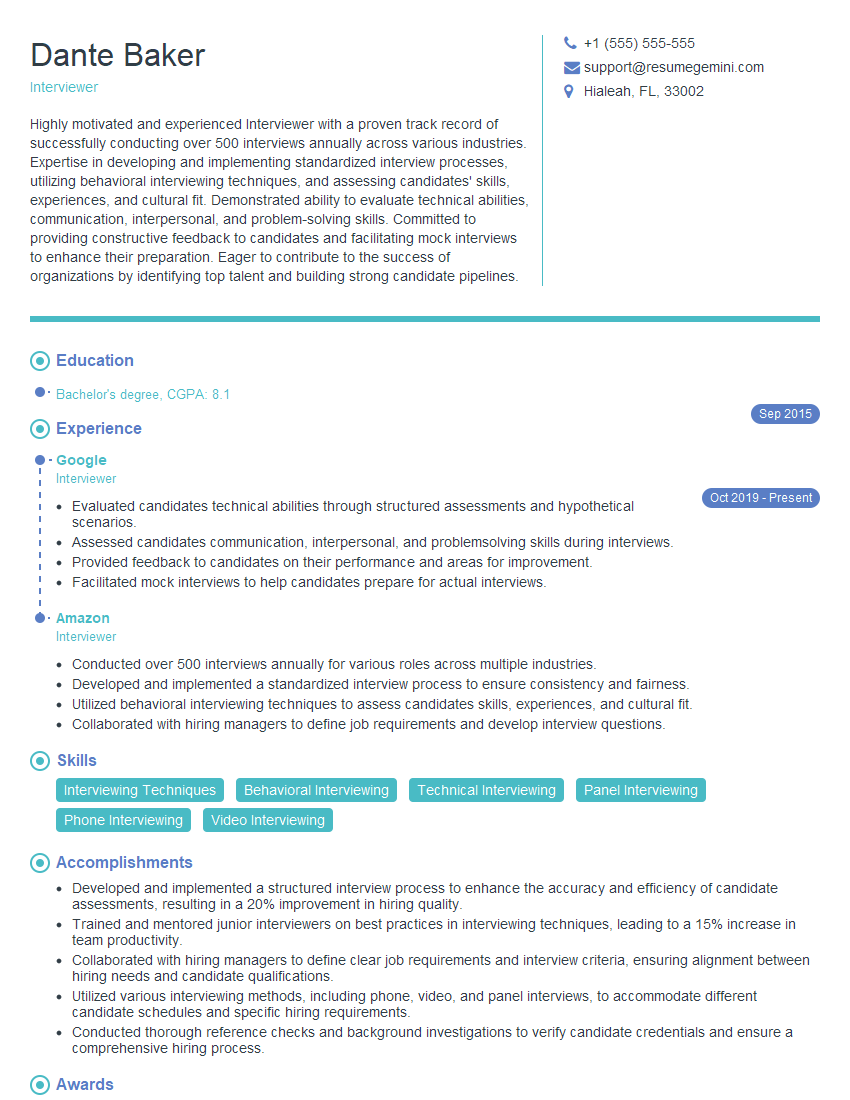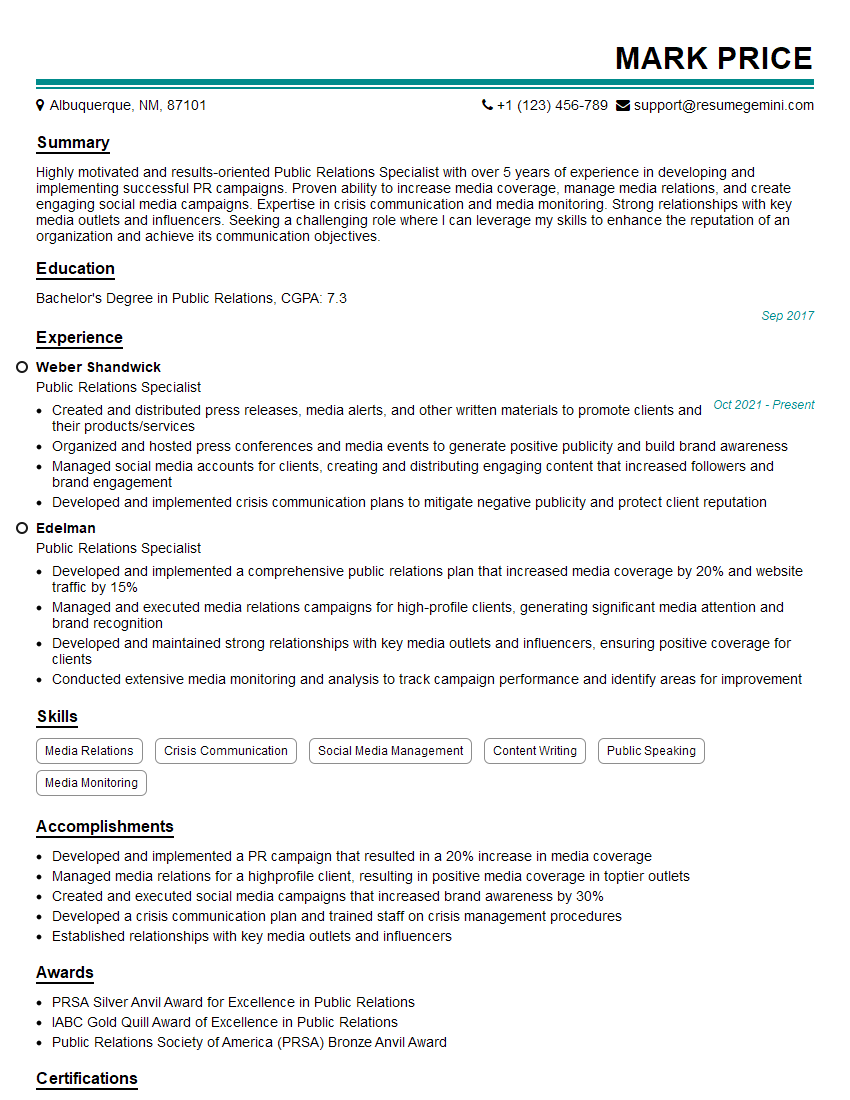Warning: search_filter(): Argument #2 ($wp_query) must be passed by reference, value given in /home/u951807797/domains/techskills.interviewgemini.com/public_html/wp-includes/class-wp-hook.php on line 324
Preparation is the key to success in any interview. In this post, we’ll explore crucial Ad-Libbing interview questions and equip you with strategies to craft impactful answers. Whether you’re a beginner or a pro, these tips will elevate your preparation.
Questions Asked in Ad-Libbing Interview
Q 1. Describe your approach to handling unexpected questions during a live presentation.
My approach to unexpected questions during a live presentation hinges on a three-pronged strategy: Acknowledge, Bridge, and Answer.
- Acknowledge: I begin by acknowledging the question, perhaps with a phrase like, “That’s a great question!” or “I’m glad you asked that.” This buys me a few crucial seconds to formulate a response and assures the audience that I’m engaged.
- Bridge: Next, I bridge the question to my prepared material. This might involve saying something like, “That connects directly to a point I was about to make about…” or, “While I don’t have the precise data to answer that specifically, the overarching principle is…”. This smoothly integrates the unexpected question into the flow of my presentation.
- Answer: Finally, I answer the question as concisely and accurately as possible. If I don’t know the answer, I honestly admit it, offering to find out and follow up later. Honesty and transparency are key.
Practicing this framework beforehand, with various potential unexpected questions, is vital. It helps build confidence and reduces the likelihood of being thrown off balance.
Q 2. How do you maintain composure and professionalism when faced with an unexpected interruption?
Maintaining composure during unexpected interruptions is paramount. My strategy involves a combination of techniques:
- Deep Breaths: Taking a few deep, slow breaths helps regulate my heart rate and calm my nerves. This is especially useful if the interruption is disruptive or aggressive.
- Positive Self-Talk: I remind myself that I’m prepared and capable. Internal affirmations like, “I’ve got this,” or “I can handle this,” can significantly boost confidence.
- Acknowledge and Redirect: I acknowledge the interruption politely and then redirect the attention back to the presentation. For example, I might say, “Thank you for your input; however, let’s return to the topic at hand.”
- Body Language: Maintaining calm and confident body language – good posture, steady eye contact – projects professionalism, even during stressful moments.
Preparation is also crucial. Knowing my material thoroughly allows me to confidently navigate unexpected events.
Q 3. Explain your strategy for quickly adapting your speech to an unforeseen change in circumstances.
Adapting my speech to an unforeseen change requires quick thinking and flexibility. My approach is based on identifying the core message and adjusting the delivery:
- Identify the Core Message: What is the most important takeaway I want my audience to remember? This anchors my response, ensuring consistency.
- Prioritize Key Points: If time is limited, I prioritize the most crucial points and streamline the presentation.
- Use Analogies and Examples: Relatable analogies or examples can help explain complex ideas quickly and make the content more accessible in a changed context.
- Improvise with Confidence: I allow myself to deviate slightly from the script, but remain focused on the main message. Confidence is contagious!
For example, if a crucial statistic becomes outdated, I can readily adapt by saying something like, “While that figure might have changed slightly recently, the core principle remains the same:…”
Q 4. How do you use pauses effectively in ad-lib situations to gather your thoughts?
Pauses are powerful tools for ad-libbing. They allow me to gather my thoughts and maintain control. I use pauses strategically:
- Strategic Silence: A brief pause before answering allows for contemplation and a more thoughtful response.
- The ‘Thinking Pause’: A slightly longer pause can convey thoughtfulness and emphasis. It’s more effective than stumbling over words.
- Transitional Pauses: Pauses are excellent for transitioning smoothly between ideas or topics, even when improvising. They avoid abrupt shifts.
- Avoid Nervous Fidgeting: Using pauses intentionally, instead of nervously filling silence with ‘ums’ and ‘ahs’, showcases confidence and professionalism.
Think of pauses as punctuation marks – they structure and give rhythm to your speech, even during improvisation.
Q 5. Share an example of when you successfully improvised during a public speaking engagement.
During a presentation on social media marketing, a participant unexpectedly raised a concern about the ethical implications of targeted advertising. While my prepared remarks focused primarily on strategy, I seamlessly integrated this crucial point. I acknowledged the concern, stating, “That’s a very important ethical consideration.” I then briefly elaborated on responsible advertising practices, drawing on my broader knowledge of the industry. This improvised segment not only addressed the audience’s concern but also strengthened the presentation’s credibility by showcasing my understanding of the subject’s nuances.
Q 6. How do you ensure your ad-libbed content remains consistent with the overall message?
Ensuring ad-libbed content aligns with the overall message involves maintaining a clear understanding of the presentation’s core theme and objectives. My approach involves:
- Connect to the Main Theme: Any improvised remarks should demonstrably link back to the central theme. This maintains coherence.
- Maintain Consistent Tone and Style: The ad-libbed section should maintain a similar tone and style as the prepared content to avoid jarring shifts.
- Reinforce Key Messages: Use the opportunity to reinforce key messages, rather than introducing completely new ideas that may distract.
- Know your Material: Deep familiarity with the subject allows for effortless integration of improvised elements.
By keeping the overarching message in mind, even spontaneous comments contribute to a cohesive and impactful presentation.
Q 7. What techniques do you employ to stay confident and maintain your audience’s engagement during impromptu speaking?
Maintaining confidence and audience engagement during impromptu speaking requires a combination of preparation, technique, and mindset:
- Thorough Preparation: A solid grasp of the subject matter is the foundation of confidence. Knowing your material well minimizes the risk of being flustered.
- Engage the Audience: Maintain eye contact, use inclusive language, and encourage participation. This creates a connection and keeps the audience invested.
- Embrace Imperfection: It’s okay to stumble occasionally. Acknowledge any mistakes briefly and move on. Authenticity is appealing.
- Positive Body Language: Project confidence through posture, gestures, and facial expressions.
- Practice Improvisation: Regularly practice improvisational speaking exercises to build comfort and fluency.
Remember, even seasoned speakers sometimes improvise. Focus on communicating your message clearly and confidently, and the audience will connect with your genuine enthusiasm.
Q 8. Describe your process for generating ideas quickly during a spontaneous speech.
Generating ideas quickly during spontaneous speech relies on a combination of mental agility and prior knowledge. Think of your mind as a well-organized toolbox; the more tools you have, the easier it is to find the right one for the job. My process involves a three-step approach:
- Keyword Association: I latch onto a keyword from the previous sentence or the question posed. From there, I let my mind free-associate, branching out to related concepts and ideas. For example, if the topic is ‘innovation,’ I might think about ‘creativity,’ ‘technology,’ ‘disruption,’ and then weave those ideas into my speech.
- Storytelling Framework: I often structure my thoughts around a simple narrative arc – beginning, middle, and end. Even a short, impromptu speech can benefit from this structure. This provides a natural flow and keeps the audience engaged.
- ‘What if?’ Scenarios: I mentally explore different angles of the topic. Asking ‘What if’ questions helps me uncover unexpected perspectives and add depth to my remarks. For instance, if discussing a challenge, I might ask, ‘What if we approached this from a completely different angle?’ and then explore that possibility.
Practicing this regularly, ideally through improv exercises, dramatically improves speed and fluency. The key is to trust your intuition and let your thoughts flow naturally.
Q 9. How do you handle criticism or unexpected negative feedback while ad-libbing?
Handling criticism or negative feedback during ad-libbing requires composure and adaptability. It’s crucial to remember that not everyone will agree with you, and that’s okay. My approach is to:
- Listen Attentively: First, I listen carefully to the feedback without interrupting. Understanding the specific concern is paramount.
- Acknowledge and Validate: I acknowledge the feedback, even if I don’t entirely agree. A simple ‘I appreciate your point of view’ goes a long way. This shows respect and opens the door for further discussion.
- Respond Thoughtfully: I respond thoughtfully, addressing the criticism directly and honestly. If the criticism is valid, I might adjust my approach. If not, I might politely explain my reasoning. It’s important to remain calm and professional, even if the feedback is harsh.
- Learn and Adapt: I use negative feedback as an opportunity to learn and improve my ad-libbing skills. What did I do that caused the negative reaction? How can I avoid this in the future?
Remember, negative feedback, while uncomfortable, is a valuable learning tool for growth. Embrace it!
Q 10. How do you incorporate audience participation or feedback into your ad-libbed responses?
Incorporating audience participation enhances engagement and makes ad-libbing more dynamic. I utilize several techniques:
- Direct Questions: I might pose a question directly to the audience, such as ‘What are your thoughts on…?’ or ‘Has anyone experienced…?’
- Indirect Engagement: I can subtly incorporate audience comments or reactions into my speech. For example, if someone laughs at a particular point, I can briefly acknowledge it and build upon the humor.
- Call and Response: For a more interactive experience, I might use a call-and-response technique, especially in a more informal setting.
- Reading the Room: It’s crucial to read the audience’s energy and adjust my approach accordingly. If the audience is quiet and reserved, I might avoid overly boisterous ad-libbing.
The key is to be natural and genuine; forced interaction feels unnatural and can backfire. The best audience participation feels spontaneous and organic.
Q 11. Explain your understanding of the relationship between preparation and successful ad-libbing.
The relationship between preparation and successful ad-libbing is symbiotic. While ad-libbing implies spontaneity, solid preparation lays the foundation for effective improvisation.
Preparation provides a strong framework of knowledge and talking points. This isn’t about memorizing a script; it’s about having a deep understanding of the subject matter. Think of it as building a strong scaffolding that supports your improvised construction. The more you know, the more you can draw upon in the moment.
Successful ad-libbing uses this preparation as a springboard for spontaneous creativity. It’s the ability to connect the dots between your pre-existing knowledge and the unique demands of the situation. A well-prepared speaker can confidently adapt and improvise with ease, smoothly weaving in unexpected turns of conversation.
In essence, preparation provides the tools; ad-libbing is the skill to use those tools effectively in an unexpected situation.
Q 12. How do you identify and utilize key talking points when adapting to unexpected situations?
Identifying and utilizing key talking points during unexpected situations involves a combination of mental organization and quick thinking. Before any speaking engagement, I identify 2-3 core messages I want to convey. These act as anchors in any situation.
When faced with the unexpected, I mentally refer to these core messages. I ask myself: ‘How can I connect this unexpected situation back to my core messages?’ I might briefly acknowledge the unexpected element (‘While I wasn’t expecting that question…’) and then deftly transition back to one of my key talking points, using the unexpected event as a springboard for further discussion. This keeps the conversation focused and ensures that my main points are communicated effectively.
For example, if I’m giving a presentation on sustainable business practices and someone asks about a competitor’s strategy, I can briefly acknowledge the competitor’s approach, but then quickly pivot to how my own approach is more sustainable and ultimately more effective in the long term – connecting the unexpected question back to my core message of sustainability.
Q 13. How do you manage your pacing and delivery when ad-libbing?
Managing pacing and delivery during ad-libbing is crucial for maintaining audience engagement. A rushed delivery can be confusing, while a slow, meandering pace can be monotonous.
To maintain a natural flow, I focus on:
- Pauses for Emphasis: Strategic pauses allow for emphasis and give the audience time to process information. They also provide me with moments to collect my thoughts.
- Varying Tone and Pitch: Monotony is the enemy of good ad-libbing. I vary my tone and pitch to keep the audience engaged. This can involve using humor, adjusting the volume for dramatic effect, or changing the rhythm of my speech.
- Observing Audience Response: I pay close attention to the audience’s reactions. If they seem lost or disengaged, I might adjust my pace or delivery.
- Practicing Breathing Techniques: Deep, controlled breaths help manage nerves and provide a more controlled and confident delivery.
Practicing mindful speaking and actively listening to my own delivery are crucial for refining this skill. Recording practice sessions can help identify areas needing improvement.
Q 14. How do you avoid rambling or losing focus while speaking spontaneously?
Avoiding rambling or losing focus during spontaneous speech requires discipline and a clear mental framework. Several techniques are effective:
- Structured Thinking: Even during improvisation, I strive to maintain a loose structure. This might involve a simple beginning, middle, and end, or a series of connected points. This internal structure helps me stay focused.
- Transition Words and Phrases: Using transition words and phrases (‘however,’ ‘in addition,’ ‘to summarize’) helps create a smooth flow between ideas and prevents me from straying too far off track.
- Self-Monitoring: I regularly check in with myself during the speech to ensure I’m staying on topic and not getting sidetracked. If I notice myself rambling, I consciously redirect myself back to the main point.
- Time Constraints: If possible, I set a mental time limit for each point, ensuring that I don’t spend too much time on any single idea.
Regular practice, including improv exercises and impromptu speaking sessions, builds the necessary mental agility to stay focused and prevent rambling.
Q 15. Describe a situation where you had to think quickly and creatively to respond to an unexpected event.
Thinking on your feet is crucial in ad-libbing. One time, I was hosting a live event and the keynote speaker’s presentation crashed mid-way through. The audience was restless, and I had to fill the gap immediately. Instead of panicking, I quickly assessed the situation. I remembered the speaker mentioning his passion for sustainable technology in his pre-event interview. I smoothly transitioned into a brief, engaging impromptu segment about the importance of technological advancement in tackling climate change. I used relatable examples and humor to keep the audience captivated until the technical issue was resolved. The audience appreciated the unexpected, relevant segment and the seamless transition, transforming a potential disaster into a moment of unexpected engagement.
Career Expert Tips:
- Ace those interviews! Prepare effectively by reviewing the Top 50 Most Common Interview Questions on ResumeGemini.
- Navigate your job search with confidence! Explore a wide range of Career Tips on ResumeGemini. Learn about common challenges and recommendations to overcome them.
- Craft the perfect resume! Master the Art of Resume Writing with ResumeGemini’s guide. Showcase your unique qualifications and achievements effectively.
- Don’t miss out on holiday savings! Build your dream resume with ResumeGemini’s ATS optimized templates.
Q 16. How do you handle difficult or controversial questions without losing your composure?
Handling difficult questions requires composure and strategic thinking. My approach involves acknowledging the question’s validity, buying a few seconds to formulate my response, and then addressing the core concerns directly but diplomatically. For example, if a question challenges a viewpoint I’ve expressed, I might say something like, ‘That’s a very insightful point, and I appreciate you bringing that up. While my initial statement focused on X, I can also see the merit in considering Y, and here’s how those perspectives can coexist…’ This acknowledges the question’s value while allowing me to articulate my position more thoroughly and thoughtfully, even if I need to adjust my stance slightly.
Q 17. What strategies do you use to stay calm and focused under pressure during spontaneous speaking?
Staying calm and focused under pressure is paramount. I practice deep breathing exercises to manage my anxiety before any public speaking event. This simple technique helps calm my nerves significantly. During spontaneous speaking, I focus on connecting with the audience, engaging their attention rather than focusing on my own anxiety. I also utilize mental rehearsal techniques, picturing myself smoothly delivering my message. This helps maintain a sense of control and confidence. If I lose my train of thought, I take a brief pause to regroup, acknowledge it calmly, and then refocus my thoughts before continuing.
Q 18. How do you tailor your ad-libbed responses to your audience’s demographics and expectations?
Tailoring responses is key. Before any ad-lib situation, I try to learn as much as possible about the audience. This involves identifying their age range, professional background, and interests. If addressing a group of tech-savvy professionals, my language would be more technical, employing jargon appropriately. For a general audience, I’d adopt a simpler, more accessible language and focus on relatable scenarios. Understanding their expectations – are they looking for entertainment, information, or inspiration? – helps direct my content to resonate and connect effectively.
Q 19. How do you use humor effectively while ad-libbing?
Humor can enhance ad-libbing, but it must be appropriate and relevant. I employ observational humor, drawing on situations familiar to the audience and relating them back to the topic at hand. For instance, if there’s a slight technical difficulty, a self-deprecating joke can diffuse tension and create a comfortable atmosphere. ‘Well, it seems even technology has a sense of humor tonight!’, said lightheartedly, can effectively disarm the situation. Crucially, humor must be tasteful and avoid anything that could alienate any part of the audience.
Q 20. What methods do you use to avoid repeating yourself or becoming monotonous during improvised speech?
Avoiding repetition and monotony requires conscious effort. I utilize a range of techniques:
- Varying sentence structure: I switch between short, impactful sentences and longer, more descriptive ones.
- Using transition words: Phrases like ‘however’, ‘furthermore’, ‘in addition’, provide smooth transitions between points.
- Incorporating storytelling: Adding brief anecdotes or examples keeps the content engaging and diverse.
- Employing rhetorical questions: These invite audience participation and encourage active listening.
Q 21. How do you prioritize clarity and conciseness when speaking spontaneously?
Clarity and conciseness are essential for effective communication, even when speaking spontaneously. I focus on using simple, direct language, avoiding jargon unless it’s truly necessary and clearly defined. Before I begin any point, I briefly outline the key message in my mind. This helps me organize my thoughts and ensure I deliver a clear, focused message. I also practice the art of ‘chunking’ information, presenting ideas in digestible pieces. This makes the information easy to follow and avoids overwhelming the audience with long, rambling sentences.
Q 22. How do you handle technical difficulties or unexpected equipment malfunctions while ad-libbing?
Handling technical difficulties during ad-libbing requires a combination of quick thinking, resourcefulness, and a positive attitude. My approach involves first acknowledging the problem – even humorously, if appropriate – to connect with the audience and let them know I’m aware of the situation. This prevents awkward silences and maintains engagement. Then, I’ll quickly assess the issue. Is it a minor interruption (like a dropped microphone) easily remedied? Or is it something more significant, requiring a pause or a change of plan?
For minor issues, I might use a bridging phrase like, “Just give me one second,” while I address the problem. For more substantial issues, I might engage the audience directly, perhaps with a humorous anecdote or by inviting questions to buy time while the technical crew works to resolve the problem. The key is to maintain composure, think on my feet, and keep the energy positive.
For example, during a live radio show, the music suddenly cut out. Instead of panicking, I calmly addressed the audience saying, “Looks like our DJ has gone rogue! While we get him back on track, let’s talk about…” and then seamlessly transitioned into a related topic, keeping the show running smoothly. Preparation is crucial too. Having backup material or a list of go-to anecdotes can be lifesavers in such situations.
Q 23. How do you assess the overall success of an ad-libbed segment after the event?
Assessing the success of an ad-libbed segment isn’t just about whether I made a mistake or said something funny. It’s a multifaceted evaluation focusing on audience engagement, message clarity, and overall flow. I consider several factors:
- Audience reaction: Was the audience attentive and receptive? Did their body language (smiles, laughter, nods) suggest positive engagement?
- Objective achievement: Did the ad-libbed segment successfully achieve its purpose? Did it help me transition smoothly, enhance a point, or address a question effectively?
- Message impact: Was the core message delivered clearly and concisely, even during improvisation?
- Post-event feedback: Following the event, gathering feedback from colleagues, the audience, and reviewing recordings helps to identify areas for improvement and reinforce successes.
For instance, after a keynote speech where I had to ad-lib a response to an unexpected question, I reviewed the recording, paying attention to both the content and my delivery. I also solicited feedback from my team, focusing on whether the response adequately addressed the question and whether it maintained the overall flow and message of the speech. This helps me refine my approach for future scenarios.
Q 24. Explain your ability to quickly analyze information and formulate concise responses under pressure.
My ability to quickly analyze information and formulate concise responses under pressure stems from years of practice in fast-paced environments. It’s a combination of active listening, pattern recognition, and a structured thought process.
When faced with a question or an unexpected situation, I first actively listen to understand the core of the issue. I then quickly identify key elements and relevant information, discarding irrelevant details. This involves recognizing patterns or similarities to previously encountered scenarios. Finally, I structure my response logically, presenting my thoughts in a concise and coherent manner, prioritizing clarity and impact. I always tailor my language and style to the specific context and audience.
For example, in a business meeting, I was asked an unexpected question about market trends. Instead of rambling, I quickly identified the three most significant factors impacting the market, briefly explained their significance, and offered a concise summary of their potential impact on our strategy. This allowed me to answer the question effectively, maintain focus, and impress with my efficiency.
Q 25. How do you differentiate between appropriate and inappropriate improvisation in different professional contexts?
Differentiating between appropriate and inappropriate improvisation depends heavily on context and audience. What works brilliantly in a stand-up comedy routine would be disastrous in a corporate board meeting. My approach involves carefully considering the following:
- Setting: Is it a formal or informal setting? A relaxed social gathering or a high-stakes professional presentation?
- Audience: Who is the audience? Their age, background, expectations, and relationship to me will influence the appropriateness of my improvisation.
- Goal: What am I trying to achieve with the improvisation? Is it to entertain, inform, persuade, or build rapport?
- Content: Is my improvisation relevant, respectful, and aligned with the overall message or tone? Avoiding potentially offensive or controversial topics is crucial.
For instance, a lighthearted joke during a team-building exercise is perfectly appropriate, but the same joke during a client presentation might be considered unprofessional. I always strive to maintain a balance between spontaneity and professionalism, ensuring my improvisation enhances the situation rather than detracts from it.
Q 26. How comfortable are you with incorporating current events or pop culture references into spontaneous conversation?
I am very comfortable incorporating current events or pop culture references into spontaneous conversation, but I do so judiciously and with awareness of the audience and context. The key is to use them tastefully and appropriately, enhancing the conversation rather than dominating it.
Before weaving in a reference, I quickly assess its relevance and potential impact. Is it widely understood and likely to resonate with the audience? Will it add humor, context, or an engaging element to the conversation? If the answer is yes, I’ll incorporate it naturally and smoothly, often using a transitional phrase to smoothly connect it to the ongoing conversation.
For example, during a casual conversation with colleagues, referencing a recent popular movie or a trending news story can help spark a fun and engaging discussion. However, I’d avoid using overly niche references or those that could be divisive or potentially offensive. The goal is to create a connection and enhance the conversation, not to showcase my knowledge of current events.
Q 27. Describe your experience with adapting your communication style to various audience types.
Adapting my communication style to various audience types is a core skill I’ve developed over time. I believe in audience-centric communication, tailoring my approach to ensure the message resonates effectively. I consider factors such as:
- Age: Younger audiences might respond better to a more informal and engaging style, while older audiences may appreciate a more formal and direct approach.
- Background and knowledge: I adjust my vocabulary and the complexity of my explanations based on the audience’s understanding of the topic.
- Culture: I am aware of and sensitive to cultural differences that might influence communication styles, ensuring my approach is respectful and appropriate.
- Setting and purpose: The setting and the overall purpose of the communication heavily influence my style. A casual setting might call for a relaxed and conversational tone, whereas a formal presentation requires a more structured and professional approach.
For instance, when presenting to a group of technical experts, I would use more technical language and delve into the specifics of the topic. However, presenting to a group of non-technical individuals would require a simpler, more accessible approach, focusing on the big picture and avoiding jargon.
Q 28. Explain your ability to transition smoothly between pre-prepared content and impromptu remarks.
Transitioning smoothly between pre-prepared content and impromptu remarks requires a seamless blend of planning and spontaneity. It’s about creating natural bridges that connect the two. I achieve this by:
- Strategic placement: I strategically place points where ad-libbing might be necessary, allowing for natural transitions without disrupting the flow. These points could be during Q&A sessions, or during moments of natural pause in my prepared remarks.
- Bridging phrases: I employ bridging phrases to create a smooth transition. Examples include, “That reminds me of…,” “Speaking of which…,” or “This leads me to another point…”
- Preparation: Even when ad-libbing, some preparation is crucial. Having a general understanding of potential questions or discussion points helps me anticipate and respond effectively.
- Flexibility: I maintain flexibility in my approach, allowing for spontaneous tangents while ensuring they connect back to the main thread of my presentation.
For example, while delivering a presentation on a new product, I might segue from a pre-prepared slide on features to an impromptu discussion on a specific customer’s feedback, using a phrase like, “This brings to mind a recent conversation with a customer who highlighted the importance of…” This allows for a natural and engaging transition between pre-planned and improvised elements.
Key Topics to Learn for Ad-Libbing Interview
- Understanding the Context: Analyze the situation, audience, and purpose before responding. Practice identifying key information quickly and efficiently.
- Structuring your Response: Develop a framework for impromptu speaking. This might involve using a simple structure like: Point, Example, Conclusion (P.E.C.).
- Vocabulary and Fluency: Expand your vocabulary and practice speaking clearly and concisely. Focus on avoiding filler words and maintaining a confident tone.
- Handling Difficult Questions: Learn techniques for gracefully addressing unexpected or challenging questions. Practice acknowledging uncertainty while still providing a thoughtful response.
- Active Listening & Engagement: Demonstrate strong listening skills by paraphrasing and summarizing key points. This shows engagement and understanding.
- Nonverbal Communication: Pay attention to your body language. Maintain eye contact, use natural gestures, and project confidence.
- Practice and Feedback: Regular practice is crucial. Record yourself, ask for feedback from trusted colleagues or mentors, and identify areas for improvement.
Next Steps
Mastering ad-libbing is invaluable for career advancement. It demonstrates quick thinking, adaptability, and strong communication skills – qualities highly sought after in many professions. To enhance your job prospects, building a strong, ATS-friendly resume is essential. ResumeGemini is a trusted resource to help you create a professional and impactful resume that highlights your abilities. Examples of resumes tailored to showcasing ad-libbing skills are available below to help guide you. Take the next step towards a successful career by crafting a resume that truly represents your potential.
Explore more articles
Users Rating of Our Blogs
Share Your Experience
We value your feedback! Please rate our content and share your thoughts (optional).
What Readers Say About Our Blog
Hi, I represent a social media marketing agency that creates 15 engaging posts per month for businesses like yours. Our clients typically see a 40-60% increase in followers and engagement for just $199/month. Would you be interested?”
Hi, I represent an SEO company that specialises in getting you AI citations and higher rankings on Google. I’d like to offer you a 100% free SEO audit for your website. Would you be interested?
